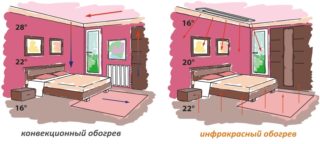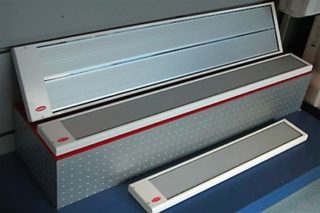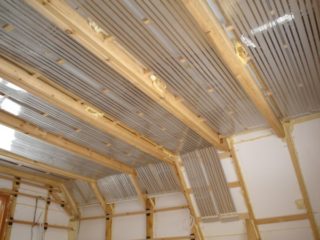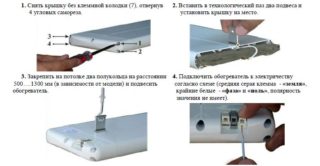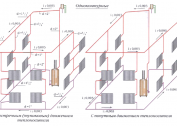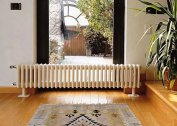A wide variety of heating devices is produced, among which ceiling infrared heaters are in great demand. When compared with convection devices, these devices are more economical, since they do not heat up the "empty space". To correctly choose this technique, you need to understand how it works, what are its features, pros and cons.
The principle of operation of the device
Conventional heaters operate on the principle of convection. They produce heated air circulating around the room.
This method has a number of disadvantages: uneven distribution of heat, rather slow heating, increased heat loss through windows and doors.
An infrared heater transmits electromagnetic radiation to objects located nearby. When the object heats up, warm air from it is redirected to the room. First, the equipment "takes" on the walls, ceiling and floor, and after that - on the air.
Pros and cons of ceiling IR heaters
Electric infrared heaters with a ceiling installation are in demand for apartments, cottages and industrial buildings. This is explained by their positive qualities:
- Efficient heating. Suspended equipment in the form of a heater does not act on air, but on objects and people.
- Efficiency reaching 90%. Compared to traditional appliances, they consume less power. Many ceiling infrared heaters are supplied with a thermostat - it is necessary to automatically turn off the heating when the set temperature is reached.
- Safe to operate. IR technology does not "dry out" the surrounding air. For this reason, it is suitable for installation in children's rooms.
- For environmental cleanliness meet European standards. For production, harmful materials hazardous to health are not used.
- Easy to install. The owner will easily cope with the installation, in addition, the mounts are already included. You can attach the technique both to the wall and to the ceiling. It is also suitable for plasterboard ceilings, only first you need to install a support bar that will hold the device. More and more often produce compact models, a few centimeters thick, for example, Ballu BIH AP 08.
There are not many drawbacks, but they should also be considered:
- Due to constant heating, painting coatings may deteriorate. If there is a humidifier at home, this problem is not observed.
- If you turn off the appliance, the room will quickly cool down.
It is difficult to call these minuses significant. In order not to be afraid of overheating, many users equip the equipment with thermostats.
What to look for when choosing
New generation devices are constantly appearing that complicate the choice of heating equipment. Arriving at the store, they first of all evaluate how the heater looks. The case must be both stylish and strong, the cable - reliable, with a high-quality plug. Frankly cheap appliances are often found in Moscow. These are better not to choose. It is very likely that low-quality components, respectively, the heater will not “live” for a long time.
An important point when choosing is power. It is calculated simply: every 10 m2 require 1.2 kW of energy.
In the reviews there are different devices, some are placed on the floor, others are attached to the wall or ceiling.After the installation method, the type of heating element is considered an equally important criterion. There are four varieties.
- Halogen. The source of infrared waves is an incandescent filament that emits visible golden light and waves in small ranges. The latter do not have the best effect on human health. Therefore, such infrared heaters are cheaper than the rest.
- Carbon. The heating element is made in the form of a quartz emitter. It heats up quickly, efficiency is the highest among this technology, but it eats a lot of electricity. Radiation is safe for human health. True, this heater cannot be used continuously.
- Ceramic. The heating element is protected by a ceramic shell, which “blocks” the emission spectrum unpleasant to the human eye. Advantages: moisture resistance, durability, profitability. Ceramic elements are being heated for a long time, the same is cooled.
- Tubular. Another name is TEN. One of the popular options suitable for continuous operation. Air does not dry out, radiation is not emitted. True, they crack slightly when the heater is turned on and off.
The type of installation and heating element are not all parameters that should be considered. Also pay attention to the functionality of the technique. Well, if the design has a thermostat, protective systems against capsizing or overheating, a remote control. All this makes the operation more safe and convenient.
Varieties of heaters
The design distinguishes the following types of heaters installed on the ceiling:
- Closed with heating panel. In them, infrared waves are absorbed both by surrounding objects and by the elements of the heater body itself (front panel). This variety is not much different from a conventional heating device, since the air is heated from the panel. The effectiveness of closed devices is small, but they are safe - they are safely installed nearby with other objects.
- Open with reflector. These ultraviolet heaters with ceiling type installation are the most common. The equipment consists of a housing, a protective grill, a power regulator, an infrared ray generator and a reflector. For the manufacture of the latter, polished aluminum is taken, which directs infrared radiation. Such a device is optionally supplemented with a thermostat.
- Film. The basis is a foil (reflector), on top of which heating elements are attached. This simple construction is covered by a strong and dense dielectric film. The device has two advantages: efficiency and accessibility.
Ceiling infrared heater - a simple but effective technique used to accumulate heat.
The process of installing the heater on the ceiling
First hang the case:
- Self-tapping screws are unscrewed from the short ends of the device, the covers are removed, and brackets are placed in the freed slots. They are fixed by a latch.
- Based on the brackets on the ceiling, they draw a markup for future fasteners (anchor hooks).
- Holes are drilled where plugs are driven into and screw fasteners are screwed.
Before fixing the equipment, wiring is laid from the input shield to the heater itself and the thermostat. A temperature controller is rarely included in a set of ceiling devices, so it is bought separately. The installation location is near the entrance to the room at an altitude of 1.6 - 1.7 m. In the equipment certificate, there is always a connection diagram that is used during installation.
Ceiling mounted heaters are not only compact, but also efficient. They are produced both by domestic (Peony, Almak) and foreign companies (Ballu, Polaris, Timberk, NeoClima).
